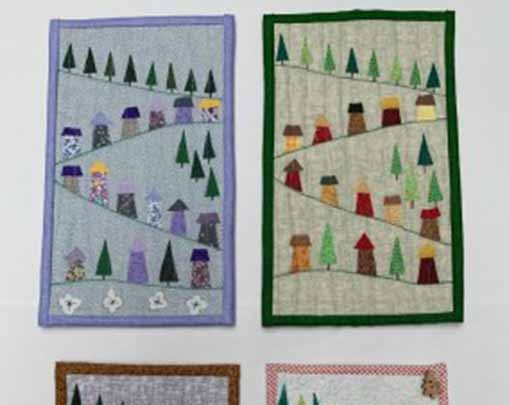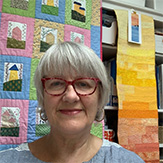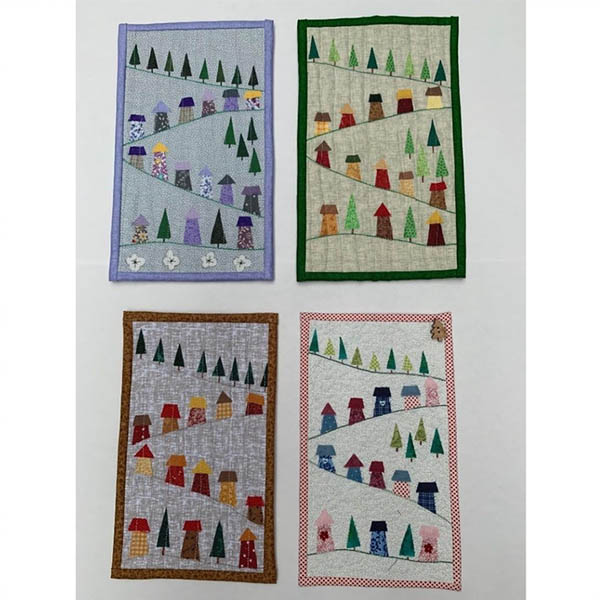Introduction to Miniature Quilts
Join Julia Gahagan in making a miniature quilt, creating a little village scene within it by using a simple shadow appliqué technique, with just fabric, glue and scissors. A transparent ‘shadow’ fabric is placed over the work to secure all the small pieces in place and completed with very easy quilting.
Once complete, your little quilt can be hung as a decorative item with small quilt hangers, fixed on a small canvas or set within a frame. Alternatively, you can use it within small projects like a notebook cover or as a pouch for glasses and gadgets.
Once you have mastered the technique there are a whole variety of design ideas to explore and fun to be had as miniature quilt making can be very addictive, especially with such a quick and easy technique.
What you will learn:
You will learn a shadow appliqué technique which Julia uses to make her miniature quilts. This will include:
- tips on the best equipment and materials to use in mini quilt making
- the importance of scaling down your fabric selection to suit miniature quilts
- the different ways to quilt your miniature project
- quick and easy binding for a miniature quilt

Materials
- A piece of thin wadding measuring 5” x 8” (12x20cm)
- A piece of background fabric measuring 5” x 8” (12 x 20cm).
- This can be a piece of plain white or cream cotton, or you could choose another plain colour.
- You could use fabric that has a pattern embossed in the background, which can look like snow if you want to create a winter or Alpine scene.
- You could use a fabric with a very faint pattern in the background as these can add a little more interest to the mini quilt than just a plain fabric.
- A piece of cotton backing fabric of any colour or design as it is on the back 5” x 8” (12x20cm)
- A piece of transparent white or cream ‘shadow’ fabric.
- Julia uses a very soft polyester tulle which is a very fine net, if you cannot source this you can purchase it from Julia’s Etsy shop www.etsy.com/shop/juliagahagan
- You could use white or cream chiffon, but it needs to be the very fine chiffon that is transparent.
- You could use ordinary polyester dress net, but this is heavier and doesn’t work quite as well as the fine net.
- Wedding net works well with the technique.
- A selection of fabrics to make up your little village scene, including green for the trees and a selection of your own choice for your houses.
- You need to decide on your colour scheme, Julia recommends no more than three colours, but you can select shades and tones for each colour. The most important selection is to combine plain and patterned fabrics and ensure that you only use very small-scale patterns. You are making a mini quilt and it is important that your fabric pattern choice is scaled down.
- Cotton Fabric for the binding cut in single strips 11/4”/3cm wide; cut four strips 11/4”/x9” (3cm x 24cm).
- A fabric glue pen (do not use wet glue pens).
- A small pair of sharp scissors.
- A fine tipped brown/black permanent marker pen.
- A lead pencil/pen to mark lines on the fabric.
- Small Pins.
- Thread to match your background fabric.
- Sewing Machine for final quilting.
- Cutting board, ruler and rotary cutter to tidy up the edges of your quilt once quilted (this can be done by hand with larger sharp scissors).
Preparation
- You will need a good working space as you follow the class, so you can sit comfortably and spread out your materials. It is good to have a base to place your work on such as a cutting board if you have one, or a tray.
- It would be good to have your sewing machine ready close by, threaded with a thread to match your backing fabric (generally cream or white).
- The main preparation is to cut your fabric choices for your trees and houses into workable sizes. These should be rectangles or squares approximately 4” x 2” / 11 x 5cm or 4” x 4” / 11 x 11 cm. These do not have to be cut exactly as it is useful to use up any other scraps that you might have which may be smaller. The key is that we do not want to be cutting out small pieces from larger pieces of fabric.

Julia Gahagan likes to make small and miniature quilts using both hand and machine stitching. She has developed a quick and easy technique to make mini quilts and enjoys teaching this to share the fun and enjoyment in making miniature quilts.
Julia has exhibited work in the UK, Europe and North America and through this exhibition work has won several awards. She attends major stitching shows across the country to teach and sell the range of kits and patterns she has designed. These are also available for sale on her Etsy shop.
Julia is a qualified adult teacher and has the City & Guilds in Patchwork & Quilting. With these skills she enjoys delivering talks and workshops all over the country, sharing her inspiration from the natural world through walking and cycling in the Surrey Hills and travel to the Mediterranean, especially the Greek Islands. Currently, Julia is working with vintage and recycled fabrics to create collaged and textured backgrounds for appliqué, quilting and embroidery.
Find out more about Julia Gahagan:
Website: juliagahagan.wordpress.com
Facebook: Miniature Quilts
LinkedIn: Julia Gahagan
Instagram: @JuliaGahagan
Only logged in customers who have purchased this product may leave a review, please Login here.




Reviews
There are no reviews yet.